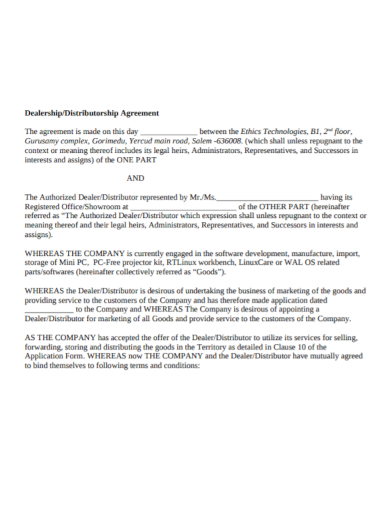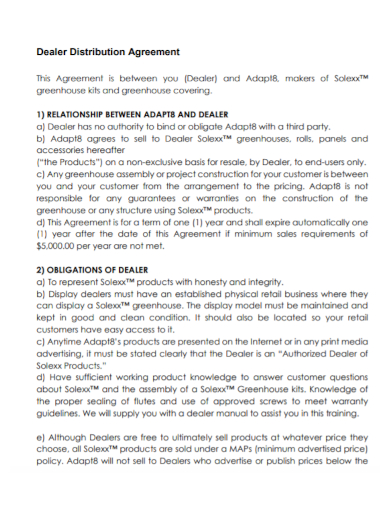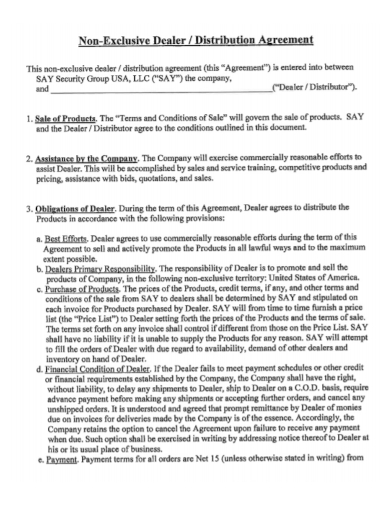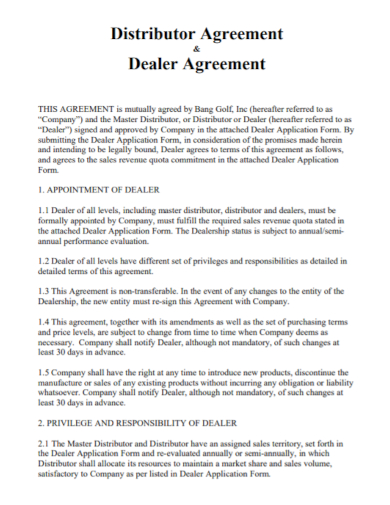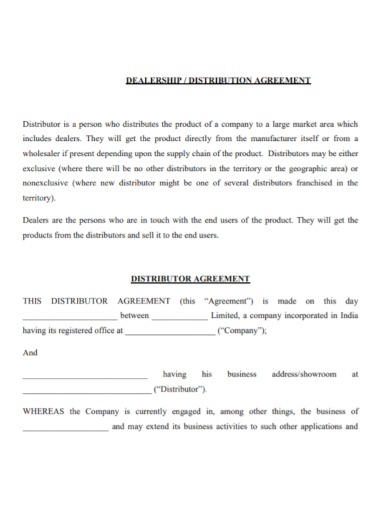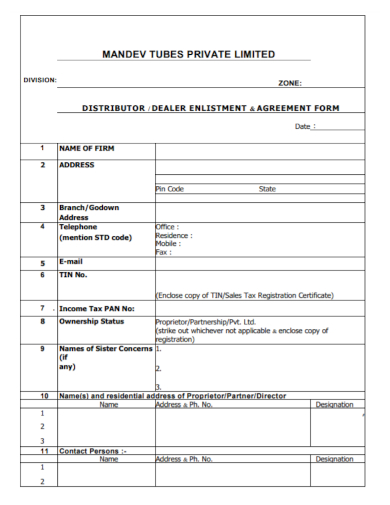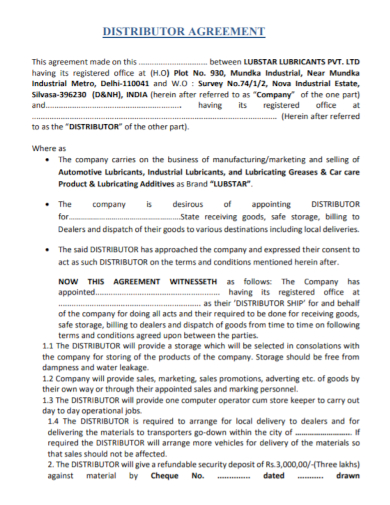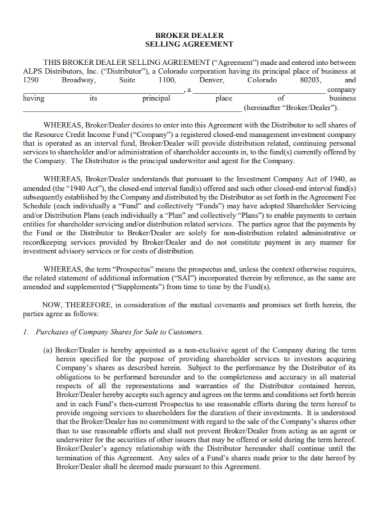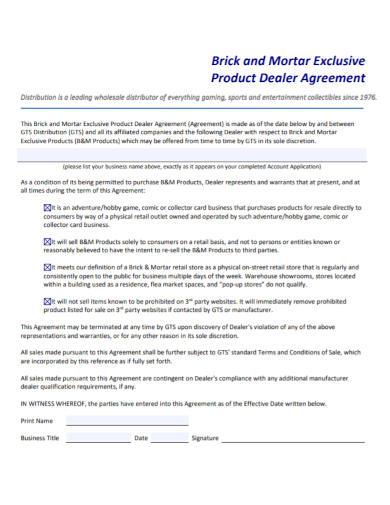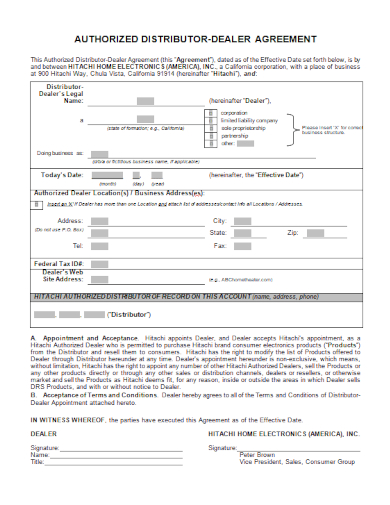The manufacturer or vendor must also decide whether the distribution deal is exclusive or nonexclusive. The specified distributor will be the sole distributor with the right to make sales within a specific geographic region or across multiple regions under an exclusive agreement. If the deal isn’t exclusive, the manufacturer or supplier may supply other distributors, who may compete in the same market. When deciding what type of agreements to enter, the manufacturer or vendor must also decide on a distribution strategy. To cover the channel partner’s target markets, a selective strategy calls for a small number of distribution outlets. Through widespread distribution, an intensive strategy aims to get the product in front of as many potential buyers as possible. Consumer-oriented products, as opposed to those designed for commercial markets, are more likely to use the latter.
10+ Dealer/Distribution Agreement Samples
Contracts between a distributor and a manufacturer are known as distribution agreements or wholesale distribution agreements. They enable the distributor to sell, market, and profit from the wholesale or bulk sales of a manufacturer’s or wholesaler’s product. The terms and conditions of a distribution agreement typically address territories, exclusivity rights, reporting requirements, and other issues.
1. Dealership/Distributorship Agreement
2. Dealer Distribution Agreement
3. Non-Exclusive Dealer/Distribution Agreement
4. Dealer and Distributor Agreement
5. Dealership/Distribution Agreement
6. Distributor/Dealer Agreement Form
7. Distributor Dealer Agreement
8. Broker-Dealer Distribution Selling Agreement
9. Authorized Distributor Dealership Agreement
10. Product Dealer Distribution Agreement
11. Editable Authorized Distributor/Dealer Agreement
How It Works
On behalf of the manufacturer, the distributor sells products directly to retailers and consumers. Instead of the manufacturer bearing the cost of sales, a distributor bears this burden. The distributor is looking for profit from products and services that are already well-known and well-developed.
The steps to finding and negotiating a distribution agreement are as follows:
Step one: Make a meeting with the manufacturer.
Step two: Negotiate the terms of distribution.
Step three: Examine particulars, such as promotional literature.
Step three: Engage the services of a business lawyer to assist you in drafting the terms.
Step four: Sign the contract or renegotiate it.
Step five: Begin putting the agreement into effect according to the provisions.
You should also choose the type of distribution agreement you want to use for your business. Because the decision you make will have a significant impact on critical marketing and legal aspects, it should be carefully considered. Business attorneys are qualified to provide legal counsel at every stage of the contract negotiation and drafting process.
A Distribution Agreement outlines the parties’ expectations for product sale and distribution, as well as the general behavior and boundaries of their relationship.
A Consignment Agreement should be used if the parties want to enter into an agreement in which the supplier retains ownership of the products and the distributor only sells the products on behalf of the supplier. In a Consignment Agreement, the distributor (referred to as the “consignee”) does not buy the products from the supplier (referred to as the “consignor”) and is only responsible for remitting the price paid by the consumer (minus any fee the consignee charges as compensation for selling the products) once the products have been sold.
FAQs
What is an exclusive distribution agreement?
Exclusive distribution agreements grant a distributor and a supplier company exclusive distribution rights. Instead of non-exclusive rights, both parties agree that the distributor will give the supplier exclusivity rights to sell certain products or services. This strategy erects barriers to participation based on competition.
What is a distribution agreement for commissions?
A distributor’s compensation for meeting or exceeding manufacturer sales goals is defined by distribution agreements for commissions. Commissions will differ depending on the specifics and value of the products sold. These agreements are a great way to encourage sales and growth while also rewarding channel partners fairly for their efforts.
The language in a distribution agreement is only as good as the language it contains. These legal errors can have unintended consequences if your agreement is unenforceable or illegal in some way. Hire contract lawyers instead of leaving your business deal to chance to ensure that your and your company’s rights are protected throughout the process.
Related Posts
FREE 10+ Mentoring Agreement Samples In MS Word | Apple Pages | PDF
FREE 10+ Partner Agreement Samples In MS Word | Google Docs | Apple Pages | PDF
FREE 10+ Individual Agreement Samples In MS Word | Google Docs | Apple Pages | PDF
FREE 10+ Strategic Agreement Samples In MS Word | Google Docs | Apple Pages | PDF
FREE 10+ Equity Agreement Samples In MS Word | Google Docs | Apple Pages | PDF
FREE 10+ Producer Agreement Samples in MS Word | Apple Pages | PDF
FREE 10+ Grant Agreement Samples In MS Word | Apple Pages | PDF
FREE 8+ Meeting Agreement Samples in MS Word | Google Docs | Apple Pages | PDF
FREE 10+ Community Agreement Samples In MS Word | Google Docs | PDF
FREE 8+ Real Estate Option Agreement Samples in MS Word | PDF
FREE 10+ Call Option Agreement Samples In MS Word | PDF
FREE 10+ Advertising Agreement Samples In MS Word | Google Docs | Apple Pages | PDF
FREE 10+ Car Agreement Samples In MS Word | Google Docs | Apple Pages | PDF
FREE 10+ Horse Agreement Samples In MS Word | Apple Pages | PDF
FREE 10+ Option Agreement Samples In MS Word | Google Docs | Apple Pages | PDF

